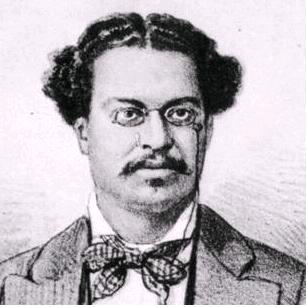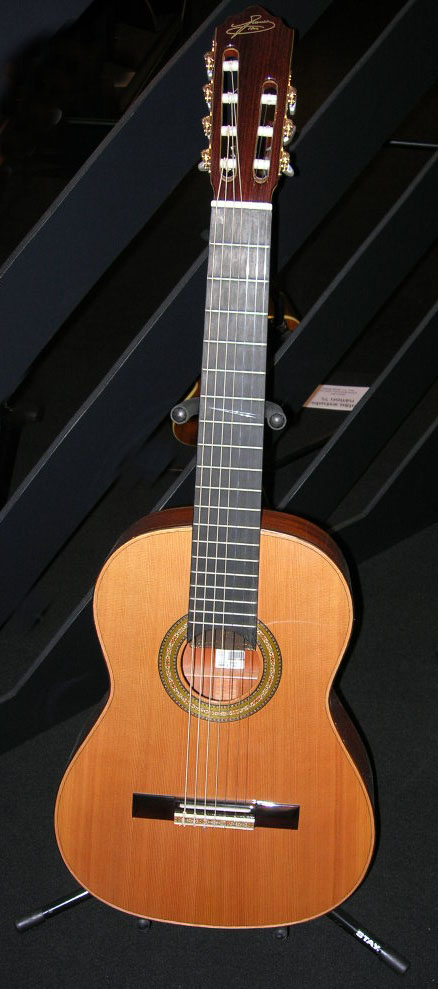|
Choro
''Choro'' (, "cry" or "lament"), also popularly called ''chorinho'' ("little cry" or "little lament"), is an instrumental Brazilian popular music genre which originated in 19th century Rio de Janeiro. Despite its name, the music often has a fast and happy rhythm. It is characterized by virtuosity, improvisation and subtle modulations, and is full of syncopation and counterpoint. Choro is considered the first characteristically Brazilian genre of urban popular music. The serenaders who play choros are known as ''chorões''. Choro instruments Originally ''choro'' was played by a trio of flute, guitar and cavaquinho (a small chordophone with four strings). Other instruments commonly played in choro are the mandolin, clarinet, saxophone, trumpet and trombone. These melody instruments are backed by a rhythm section composed of 6-string guitar, seven-string guitar (playing bass lines) and light percussion, such as a pandeiro. The cavaquinho appears sometimes as a melody instrume ... [...More Info...] [...Related Items...] OR: [Wikipedia] [Google] [Baidu] |
Pixinguinha
Alfredo da Rocha Viana Filho (May 4, 1897 – February 17, 1973), better known as Pixinguinha, () was a Brazilian composer, arranger, flutist, and saxophonist born in Rio de Janeiro. He worked with Brazilian popular music and developed the '' choro'', a genre of Brazilian music that blends Afro-Brazilian rhythms with European influences. Some of his compositions include "Carinhoso", "Glória", "Lamento", and "Um a Zero". Pixinguinha merged the traditional music of 19th-century composers with modern jazz-inspired harmonies, sophisticated arrangements, and Afro-Brazilian rhythms. This is attributed as having helped establish ''choro'' as an aspect of Brazilian culture. Pixinguinha was among the first Brazilian musicians to embrace radio broadcasting and studio recording, technologies that played a key role in bringing his music to a broader audience. Early life and career Pixinguinha was born to musician Alfredo da Rocha Viana, a flutist with an extensive collection of ''choro ... [...More Info...] [...Related Items...] OR: [Wikipedia] [Google] [Baidu] |
Music Of Brazil
The music of Brazil encompasses various regional musical styles influenced by European, Music of the United States, American, African and Amerindian forms. Brazilian music developed some unique and original styles such as forró, repente, coco de roda, axé, sertanejo music, sertanejo, samba, bossa nova, Música popular brasileira, MPB, Brazilian gaucho music, gaucho music, pagode, tropicália, choro, maracatu, embolada (coco de repente), frevo, brega (music), brega, modinha and Brazilian versions of foreign musical styles, such as rock, pop music, Soul music, soul, hip-hop, disco music, country music, Ambient music, ambient, Industrial music, industrial and Psychedelic music, psychedelic music, Rapping, rap, classical music, fado, and Gospel music, gospel. Samba has become the most known form of Brazilian music worldwide, especially because of the country's brazilian carnival, carnival, although bossa nova, which had Antônio Carlos Jobim as one of its most acclaimed composers ... [...More Info...] [...Related Items...] OR: [Wikipedia] [Google] [Baidu] |
Chiquinha Gonzaga
Francisca Edwiges Neves Gonzaga, better known as Chiquinha Gonzaga (; October 17, 1847 – February 28, 1935) was a Brazilian composer, pianist and the first woman conductor in Brazil. Chiquinha Gonzaga was the first pianist of " choro" and author of the first carnival march, "Ó Abre Alas" (1899). Her plays and operettas, such as ''Forrobodó'' and ''Jurití'', were a great success with the public because they used elements of Brazilian popular culture of the time. Biography Early life Chiquinha Gonzaga was born in Rio de Janeiro, from a pardo mother and a wealthy white father – after she was born her father became a marshal. Her godfather was Luís Alves de Lima e Silva, Duke of Caxias. For her mother, a mestizo and poor woman, the birth of Chiquinha was a very difficult, in part because of the risk that the father would not recognize the paternity of her daughter. Indeed, José Basileu, the military promising career, from a wealthy family, suffered from the pressu ... [...More Info...] [...Related Items...] OR: [Wikipedia] [Google] [Baidu] |
Benedito Lacerda
Benedicto Lacerda (14 March 1903 – 16 February 1958) was a Brazilian composer, flutist, and maestro.Biography on Site Letras A long-time player of , he is most well known for his collaborations with famous saxophonist . Biography Lacerda was born in 1903 in the city of , the child of washerwoman Dona Lousada. He later moved with his mother to the city of |
Seven-string Guitar
The seven-string guitar adds one additional string to the more common six-string guitar, commonly used to extend the bass range (usually a low B) or also to extend the treble range. The additional string is added in one of two different ways: by increasing the width of the fingerboard such that the additional string may be fretted by the left hand; or, by leaving the fingerboard unchanged and adding a "floating" bass string. In the latter case, the extra bass string lies next to the existing bass strings, but free of the fingerboard in similar fashion as the archlute and theorbo. Such unfrettable bass strings were historically known as diapasons or bourdons. Some types of seven-string guitars are specific to certain cultures such as the Russian guitar, Russian, Guitarra séptima, Mexican, and Brazilian guitars. History The history of the seven-string guitar stretches back more than 230 years. During the Renaissance period (), the European guitar generally had four course (mus ... [...More Info...] [...Related Items...] OR: [Wikipedia] [Google] [Baidu] |
Mandolin
A mandolin (, ; literally "small mandola") is a Chordophone, stringed musical instrument in the lute family and is generally Plucked string instrument, plucked with a plectrum, pick. It most commonly has four Course (music), courses of doubled Strings (music), strings tuned in unison, thus giving a total of eight strings. A variety of string types are used, with steel strings being the most common and usually the least expensive. The courses are typically tuned in an interval of perfect fifths, with the same tuning as a violin (G3, D4, A4, E5). Also, like the violin, it is the soprano member of a Family (musical instruments), family that includes the mandola, octave mandolin, mandocello and mandobass. There are many styles of mandolin, but the three most common types are the ''Neapolitan'' or ''round-backed'' mandolin, the ''archtop'' mandolin and the ''flat-backed'' mandolin. The round-backed version has a deep bottom, constructed of strips of wood, glued together into a bowl. Th ... [...More Info...] [...Related Items...] OR: [Wikipedia] [Google] [Baidu] |
Polka
Polka is a dance style and genre of dance music in originating in nineteenth-century Bohemia, now part of the Czech Republic. Though generally associated with Czech and Central European culture, polka is popular throughout Europe and the Americas. History Etymology The term ''polka'' referring to the dance is believed to derive from the Czech words "půlka", meaning "half-step". Czech cultural historian Čeněk Zíbrt attributes the term to the Czech word ''půlka'' (half), referring to both the half-tempo and the half-jump step of the dance.Čeněk Zíbrt, "Jak se kdy v Čechách tancovalo: dějiny tance v Čechách, na Moravě, ve Slezsku a na Slovensku z věků nejstarších až do nové doby se zvláštním zřetelem k dějinám tance vůbec", Prague, 189(Google eBook)/ref> This name has been changed to "Polka" as an expression of honour and sympathy for Poland and the Poles after the November Uprising 1830-1831. "Polka" meaning, in both the Czech and Poli ... [...More Info...] [...Related Items...] OR: [Wikipedia] [Google] [Baidu] |
Lundu (dance)
Lundu (also spelled landu or landum) is a style of Afro-Brazilian music and dance with its origins in the African Bantu and Portuguese people. History The interconnectedness of Lusophone countries dates back to the Atlantic Slave Trade, between Portugal, Brazil and regions of Africa. In the 15th century, the Portuguese were the primary exporters of African slaves to the Americas, and with slaves came their musical traditions. Throughout the 17th and 18th centuries, there was a massive Brazilian presence in Angola, enabling a cultural exchange between the two Portuguese colonies. This exchange enabled subtle amalgamations of musical styles between Angola, Brazil and other African slave trade countries. The establishment of a creole population in Brazil led to further cultural developments in language, religion and art. In 1859, French journalist Charles Ribeyrolles described Afro-Brazilian free practices on a '' fazenda'' in Rio de Janeiro province: Dissemination Reco ... [...More Info...] [...Related Items...] OR: [Wikipedia] [Google] [Baidu] |
Joaquim Callado003
Joaquim is the Portuguese and Catalan version of Joachim and may refer to: * Agnes Joaquim (born Ashkhen Hovakimian, 1854–1899), Singaporean Armenian who bred Singapore's first hybridised orchid hybrid, Vanda 'Miss Joaquim' * Alberto Joaquim Chipande, politician * Eduardo Joaquim Mulémbwè, politician * Joaquim Agostinho (1943–1984), Portuguese professional bicycle racer * Joaquim Amat-Piniella (1913–1974), Catalan writer and politician * Joaquim Antonio (Callado) da Silva (1848–1880), Brazilian composer and flutist * Joaquim António de Aguiar (1792–1884), Portuguese politician * Joaquim Arcoverde de Albuquerque Cavalcanti (1850–1930), first Cardinal to be born in Latin America * Joaquim Augusto Mouzinho de Albuquerque (1855–1902), Portuguese soldier * Joaquim Benedito Barbosa Gomes, first black Supreme Federal Tribunal justice in Brazil * Joaquim Carvalho (1937–2022), Portuguese football goalkeeper * Joaquim Coulanges (born 2006), Canadian soccer p ... [...More Info...] [...Related Items...] OR: [Wikipedia] [Google] [Baidu] |
Corta Jaca (song)
Corta Jaca may refer to: * Corta Jaca (dance), a traditional Brazilian dance * Corta Jaca (ballroom Maxixe), a dance step described for the version of Maxixe in North American and Merican ballrooms * Corta Jaca (samba step), a step from the syllabus of the International Style ballroom samba * Corta Jaca (song), a song by Chiquinha Gonzaga {{disambig ... [...More Info...] [...Related Items...] OR: [Wikipedia] [Google] [Baidu] |
Schottische
The schottische is a partnered country dance that apparently originated in Bohemia. It was popular in Victorian-era ballrooms as a part of the Bohemian folk-dance craze and left its traces in folk music of countries such as Argentina (Spanish Wikipedia and ), Finland (), France, Italy, Norway (""), Portugal and Brazil (, '), Spain (), Sweden, Denmark (), Mexico (), and the United States, among other nations. The schottische is considered by '' The Oxford Companion to Music'' to be a kind of slower polka, with continental-European origin. The schottische basic step is made up of two sidesteps to the left and right, followed by a turn in four steps. In some countries, the sidesteps and turn are replaced by strathspey hopping steps. Schottisches danced in Europe (in the context of balfolk), where they originated, are different from how they are danced in the United States. The European or Continental version (often pronounced "skoteesh"), is typically danced to faster music a ... [...More Info...] [...Related Items...] OR: [Wikipedia] [Google] [Baidu] |




